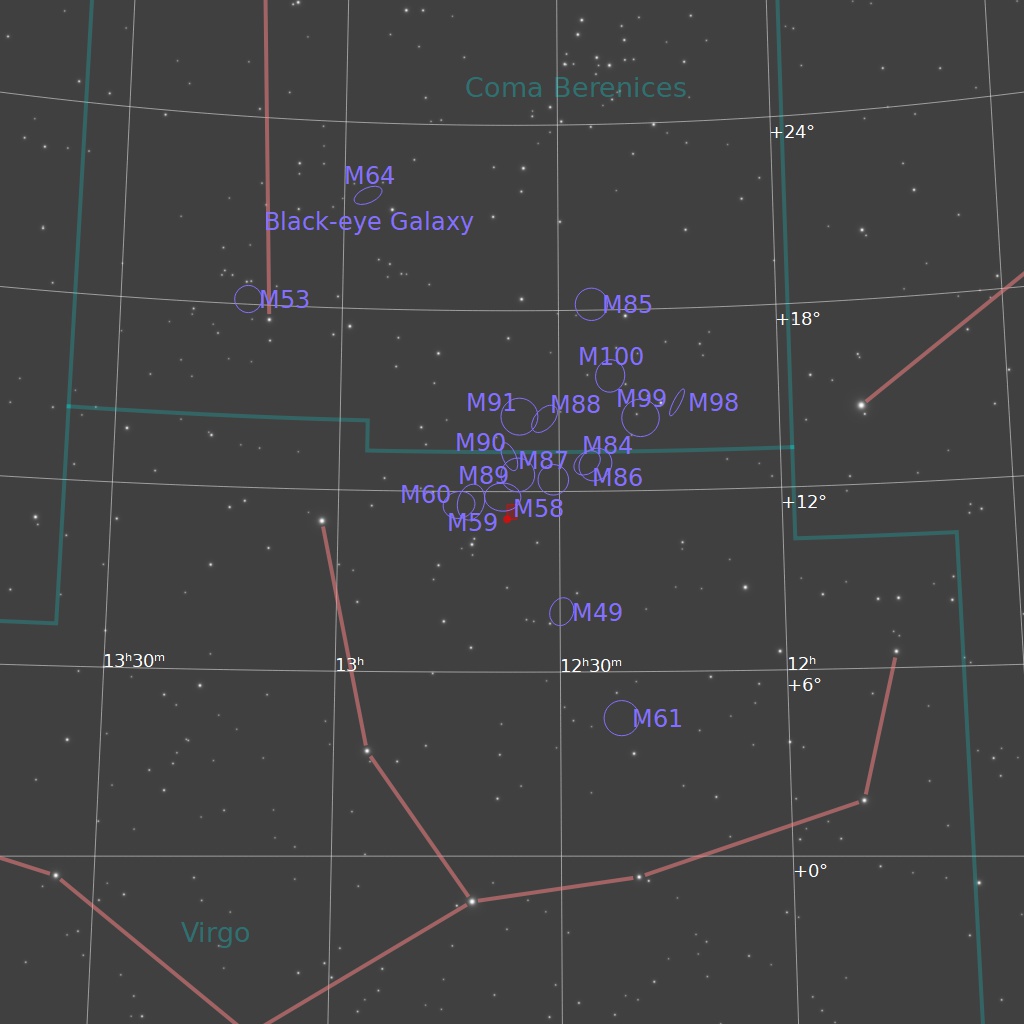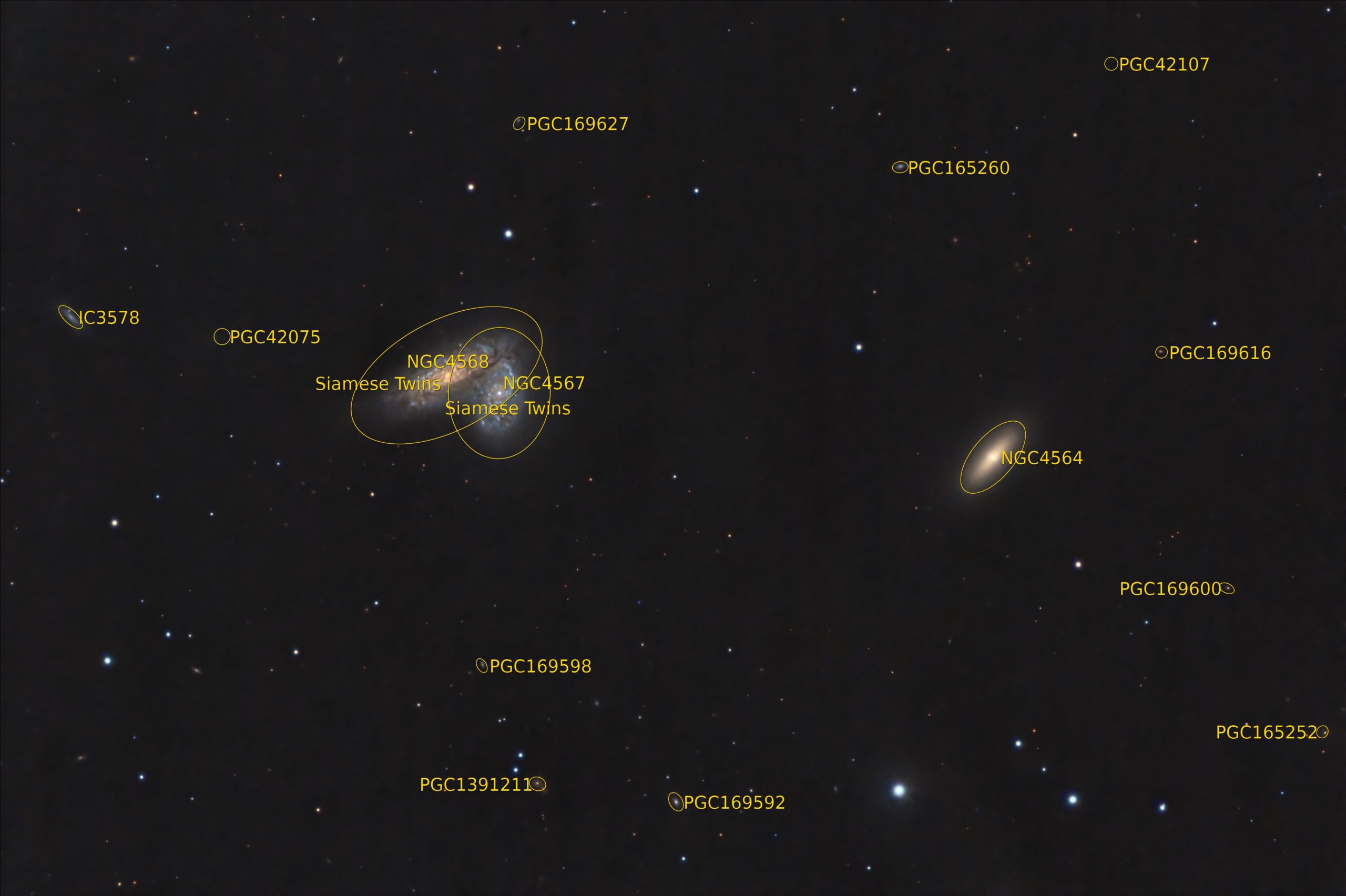NGC 4567 and NGC 4568
 Click image for full size version
Click image for full size version
April 14, 2024
The pair of interacting galaxies on the left half of this image includes NGC 4567 NGC (right) and NGC 4568 (left). This pair is sometimes called the “Butterfly Galaxies,” and lies in Virgo 62 million light years away. Both galaxies are unbarred spiral galaxies. They’ll eventually merge into an elliptical galaxy in half a billion years or so.
On the right side of the image is NGC 4564. It’s a little closer, at 57 million light years away. It reportedly hosts a black hole with a mass 56 million times that of the Sun!
There are several other more distant galaxies around the field. I prepared an annotated image identifying some of them.
Tekkies:
Acquisition, focusing, and control of Paramount MX mount with N.I.N.A., TheSkyX. Guiding with PHD2. Primalucelab low-profile 2″ Essato focuser and ARCO rotator. Equipment control with PrimaLuce Labs Eagle 4 Pro computer. All pre-processing and processing in PixInsight. Acquired from my SkyShed in Guelph. Data acquired under little to no moonlight and average transparency and seeing between March 28-29, 2024.
Celestron 14″ EDGE HD telescope at f/11 (3,912 mm focal length) and QHY600M camera binned 2×2 with Optolong filters.
50 x 1m Red = 0hr 50m
51 x 1m Green = 0hr 51m
47 x 1m Blue = 0hr 47m
Total: 2hr 28m
Preprocessing: The WeightedBatchPreProcessing script was used to perform calibration, cosmetic correction, weighting, registration, local normalization, integration and Drizzle integration of all frames.
RGB master: A master RGB image was made from the Red, Green and Blue masters using ChannelCombination in RGB mode.
Synthetic Luminance: A SynthL was made by integrating the three masters, weighted by SNR, with no pixel rejection
Gradient Removal: DBE was used to remove gradients from the RGB and SynthL masters.
Colour Calibration: SpectroptometricColorCalibration was used to calibrate the RGB master.
Deconvolution: BlurXterminator was applied to the RGB and SynthL masters with Automatic psf , star sharpening set to 0.5, and non-stellar set to 0.5.
Star Removal: StarXterminator was used to remove the stars from the RGB and SynthL masters, with default settings, except Large Overlap was selected. The RGB and SynthL stars-only images were retained.
Linear Noise Reduction: NoiseXterminator was applied to the RGB and SynthL masters with settings Amount=0.9 and Detail=0.25
Stretching: HistogramTransformation was applied to the RGB and SynthL masters to make pleasing images. Approximate background level after stretch was 0.1 for SynthL and 0.08 for RGB.
Nonlinear Processing
Combinining SynthL and RGB: LRGBCombination was used to replace the lightness channel of the RGB image with the SynthL.
Nonlinear Noise Reduction: NoiseXterminator was used to reduce noise in the background areas of the SynthRGB master with Amount=0.9 and Detail=0.15.
Re-stretch: HistogramTransformation was used to boost contrast by moving the dark point to the toe of the histogram and slightly decreasing the mid-point slider.
Contrast Enhancement: LocalHistogramEqualization was applied twice. A Contrast Limit of 1.5 and 1 iteration was used for each LHE application (scale 40, strength 0.2; scale 125, strength 0.15).
Sharpening: MultiscaleMedianTransform was applied. (Layers 1 – 3 with strengths of 0.01, 0.1, and 0.1, respectively), using a mask to select only the galaxies.
Contrast, Brightness and Colour: Background and galaxy brightness, contrast, and saturation were adjusted in several iterations using CurvesTransformation with masks as required.
Stars-only steps: HistogramTransformation was applied to the RGB and SynthL stars-only images. They were combined as for the starless images using LRGBCombination. The SynthL stars-only was then used as a mask and CurvesTransformation CIE c* slider was used to boost colour in the stars.
Star Restoration: PixelMath expression combine(starless, stars, op_screen()) was used to combine the starless SynthLHaRGB starless image with the stars-only image.
Final Steps: Background, galaxy, and star brightness, contrast, hue, and saturation were adjusted in several iterations using CurvesTransformation with masks as required. ICCProfileTransformation (sRGB IEC61966-2.1; Relative Colorimetric with black point compensation) was applied prior to saving as a jpg. The finder chart was made using the FindingChart process. The annotated version was made using the AnnotateImage script.








Thanks Ron! Great stuff.
Great explanation of your work, always learning from you!! Thanks